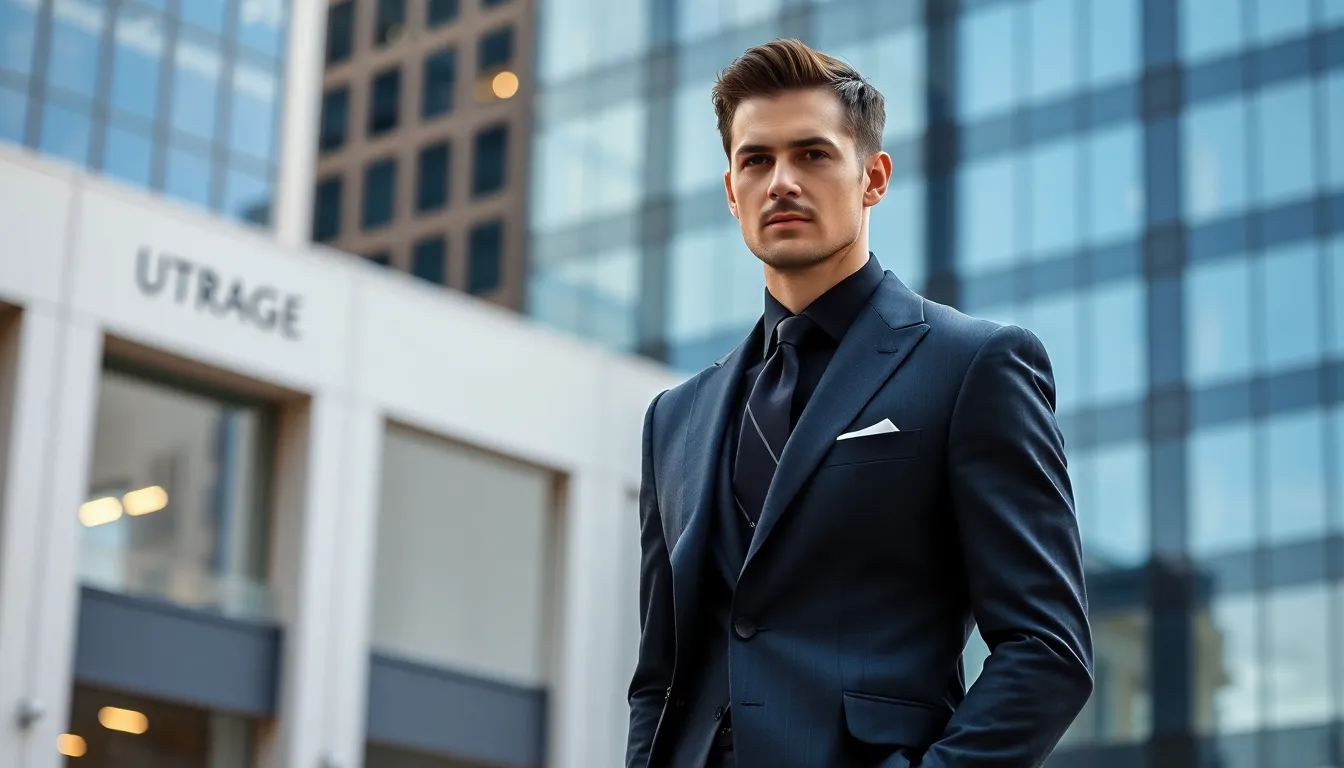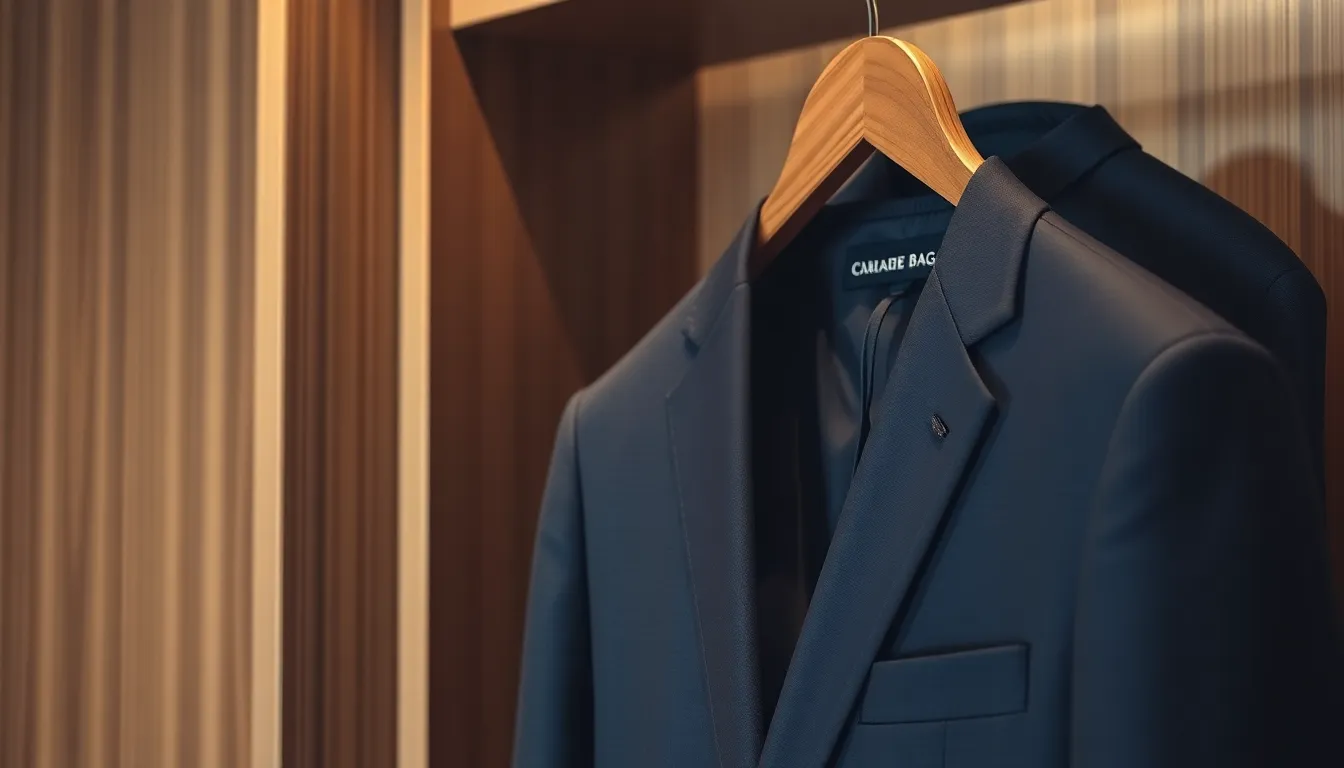When we think of sophistication and timeless elegance, Italian suits for men immediately come to mind. These masterfully crafted garments represent centuries of tailoring expertise and artisanal tradition that transforms any man into a vision of refined style. From the bustling fashion houses of Milan to the historic ateliers of Naples, Italian suit makers have perfected the art of creating clothing that doesn’t just fit—it elevates.
We’ve all witnessed the magnetic confidence that comes from wearing a perfectly customized Italian suit. The way the fabric drapes naturally across the shoulders, the impeccable attention to detail in every stitch, and that unmistakable silhouette that commands respect in any room. Whether you’re stepping into a boardroom meeting or attending a black-tie event, nothing quite matches the sophisticated appeal of authentic Italian craftsmanship.
Today’s discerning gentleman understands that investing in a quality Italian suit isn’t just about looking good—it’s about making a statement that speaks volumes before you even say a word.
The Timeless Appeal of Italian Craftsmanship in Men’s Suits
Italian suits represent centuries of artisanal mastery that continues to set the global standard for luxury menswear. We’re exploring how this enduring tradition creates garments that transcend fleeting fashion trends.
Heritage of Italian Tailoring Excellence
Italian tailoring excellence traces back to the Renaissance period when skilled artisans first established workshops in Milan, Naples, and Rome. Master craftsmen passed down techniques through generations, creating a lineage of expertise that we still witness today in renowned houses like Brioni, Ermenegildo Zegna, and Kiton.
Regional specializations emerged across Italy’s fashion capitals, with each area developing distinct approaches to construction and finishing. Neapolitan tailors perfected the soft shoulder construction that allows natural drape and movement. Milanese craftsmen focused on structured silhouettes with precise engineering. Roman tailors emphasized elegant proportions and refined details.
Traditional handwork remains central to authentic Italian suit construction, with skilled artisans dedicating 18-25 hours to complete a single garment. Canvas construction provides superior structure compared to fused alternatives, ensuring the suit maintains its shape over decades of wear. Hand-padded lapels, pick-stitched edges, and functional buttonholes demonstrate the meticulous attention that defines genuine Italian craftsmanship.
Why Italian Suits Define Sophisticated Style
Italian suits define sophisticated style through their perfect balance of formal structure and natural elegance. We observe how Italian designers create silhouettes that flatter the male form without sacrificing comfort or mobility. The result is a garment that appears effortlessly refined while maintaining the wearer’s natural posture and movement.
Luxurious fabric selection sets Italian suits apart from mass-produced alternatives, with mills like Loro Piana, Ermenegildo Zegna, and Holland & Sherry providing the finest wools, cashmeres, and silks. These premium materials drape beautifully and age gracefully, developing character over time rather than showing wear.
Color palettes in Italian suiting reflect sophisticated restraint, favoring rich navies, charcoal grays, and deep browns over flashy patterns. Subtle details like contrasting linings, horn buttons, and discreet monogramming add personality without compromising the suit’s versatility across business and social settings.
Construction techniques like the “spalla camicia” (shirt shoulder) create a natural, unpadded shoulder line that moves with the wearer’s body. This approach eliminates the rigid, armored appearance of heavily structured suits while maintaining proper proportions and elegant lines.
Essential Characteristics That Make Italian Suits Distinctively Classy

When we examine what makes Italian suits the gold standard of menswear, three fundamental characteristics consistently emerge. These defining elements work together to create the sophisticated elegance that has made Italian tailoring legendary worldwide.
Superior Fabric Quality and Selection
Luxurious materials form the foundation of every exceptional Italian suit. We see craftsmen selecting fine wool, cashmere, and silk blends that provide both comfort and durability. These premium fabrics create an elegant drape that naturally flatters the wearer’s silhouette while maintaining their shape over time.
Quality extends beyond basic materials to specialized textile construction. Italian mills produce fabrics with superior weave patterns that enhance breathability and movement. The result is clothing that feels as exceptional as it looks, allowing wearers to move with confidence throughout their day.
Impeccable Construction Techniques
Meticulous craftsmanship defines every aspect of Italian suit construction. We observe tailors creating slim, tapered fits with high armholes that deliver both comfort and a streamlined appearance. These techniques ensure the suit moves naturally with the body rather than restricting movement.
Structural elements reflect centuries of refined tailoring expertise. Jackets feature shorter cuts, higher button stances, flapless pockets, and ventless backs that contribute to a clean, modern aesthetic. This approach emphasizes the wearer’s best features while creating a balanced silhouette that appears effortless.
Body contouring techniques elevate the overall fit and appearance. Italian tailors master the art of highlighting desirable features while minimizing less flattering areas. Their construction methods achieve the perfect balance between structure and comfort, creating suits that feel custom made.
Attention to Detail and Finishing
Every stitch reflects deliberate precision rooted in Italian tailoring tradition. We find craftsmen from Milan, Naples, and Rome applying centuries of expertise to create flawless finishing touches. Button placement, smooth lapels, and elegant lining choices demonstrate this commitment to excellence.
Subtle design elements distinguish authentic Italian suits from mass produced alternatives. State of the art sartorial innovation combines with traditional techniques to create distinctive style statements. These details ensure each suit represents more than clothing but rather a sophisticated expression of personal taste.
Balanced construction creates the signature Italian aesthetic of refined elegance. Suits achieve a slim profile without appearing stiff or overly structured. This approach embodies an effortless fashion forward attitude that balances flair with timeless sophistication, making Italian suits the preferred choice for discerning gentlemen worldwide.
Top Italian Suit Brands Every Gentleman Should Know

When selecting the perfect Italian suit, understanding the heritage and craftsmanship behind iconic brands makes all the difference. We’ve curated the most prestigious names that continue to define excellence in men’s tailoring.
Armani: The Pioneer of Modern Italian Elegance
Armani revolutionized the industry of men’s suiting by introducing a sleek, minimalist approach that changed fashion forever. Giorgio Armani’s vision transformed traditional Italian tailoring into something entirely modern, creating clean lines and perfect fits that became the benchmark for stylish menswear. We see Armani’s influence in every contemporary suit design, as their pioneering work established the foundation for modern Italian elegance.
The brand’s signature style focuses on understated sophistication rather than flashy details. Armani suits feature soft construction techniques that create a natural drape while maintaining structure. Their minimalist aesthetic appeals to gentlemen who prefer refined luxury without excessive ornamentation, making these suits perfect for both business settings and formal occasions.
Brioni: Handcrafted Luxury and Precision
Brioni represents the absolute pinnacle of Italian tailoring, where ultra-luxurious craftsmanship meets uncompromising quality standards. Every Brioni suit is expertly hand-constructed by in-house tailors who use only the finest fabrics available in the industry. We find that their attention to detail is unmatched, with some customization options having no upper price limit due to the level of personalization available.
Industry leaders and Hollywood royalty choose Brioni for its exceptional quality and lifetime value. The brand offers both off-the-rack and made-to-measure options, ensuring that every gentleman can access their legendary craftsmanship. Brioni suits symbolize high investment pieces that maintain their elegance and structure for decades, making them true heirloom garments.
Canali: Traditional Craftsmanship Meets Contemporary Style
Canali masterfully blends time-honored Italian tailoring techniques with modern design sensibilities. The brand focuses on exquisite wool fabrics and precise construction methods that create suits with both classic appeal and contemporary relevance. We appreciate how Canali maintains traditional craftsmanship while adapting to current style preferences.
Their suits feature versatile designs that work seamlessly across different occasions and settings. Canali’s commitment to refined taste shows in every detail, from fabric selection to final finishing touches. The brand creates classic yet adaptable pieces that appeal to gentlemen who value both tradition and modern sophistication.
Ermenegildo Zegna: Innovation in Luxury Menswear
Founded in 1910, Zegna has established itself as a leader in producing some of the industry’s most refined premium fabrics. The company developed its own textile production capabilities in the late 1960s, allowing them to control every aspect of fabric quality and innovation. We recognize Zegna as the brand that perfectly balances traditional tailoring with cutting-edge materials and techniques.
Zegna suits are designed for men who appreciate quiet luxury and exceptional comfort. Their elegant yet lightweight construction makes these suits ideal for discerning gentlemen who demand both sophistication and practicality. The brand provides both off-the-rack and bespoke options, ensuring that innovative materials meet traditional craftsmanship in every garment they create.
Perfect Fit Guidelines for Italian Suits

Achieving the perfect Italian suit fit requires understanding exact measurements and tailoring principles that create the signature silhouette we admire. We’ll guide you through the essential elements that transform a good suit into an exceptional one.
Understanding Italian Sizing Standards
Italian sizing operates differently from US and UK standards, using chest circumference measurements in centimeters or European sizing numbers. We typically see Italian sizes ranging from 44 to 62, with each number correlating to exact chest and waist measurements.
Size 48 represents the most common Italian size, corresponding roughly to a US size 38 with a 32-33 inch waist. The sizing scale reflects jacket chest measurements taken under the arm around the entire body circumference. Converting between systems becomes crucial when selecting your Italian suit size.
European sizing numbers provide more precise measurements than traditional US sizing. We recommend measuring your chest circumference in centimeters for the most accurate Italian size selection. Most Italian brands follow these standardized measurements consistently across their collections.
Key Measurements for Optimal Tailoring
Chest circumference forms the foundation of Italian suit sizing, measured fully around the chest below the armpits. This measurement determines the jacket size and ensures proper fit across the torso.
Waist measurements around your natural waistline create the tapered silhouette characteristic of Italian suits. The jacket should sit snugly without tightness, emphasizing the V-shaped torso that defines Italian tailoring.
Shoulder width maintains the clean Italian shoulder line without creating wrinkles or pulling. Perfect shoulder fit cannot be altered significantly, making this measurement critical during initial selection.
Sleeve length allows shirt cuffs to peek out slightly, typically showing about half an inch of shirt beneath the jacket sleeve. This detail adds sophistication to the overall appearance.
Jacket length must be proportionate to your height, creating balanced proportions that enhance your natural silhouette. Italian suits favor slightly shorter jackets that modernize the classic aesthetic.
| Measurement | Purpose | Italian Standard |
|---|---|---|
| Chest | Jacket size determination | Snug but comfortable |
| Waist | Tapered silhouette | Natural waistline |
| Shoulders | Clean line maintenance | No wrinkles or pulling |
| Sleeves | Shirt cuff visibility | 0.5 inch showing |
| Jacket length | Proportional balance | Slightly shorter cut |
Alterations That Enhance the Classic Italian Silhouette
Taking in the waist creates the slim, customized silhouette that defines Italian suit aesthetics. This alteration transforms a standard fit into the coveted tapered look that flatters most body types.
Adjusting shoulders requires expert craftsmanship since this alteration affects the entire jacket structure. Perfect shoulder fit eliminates wrinkles and maintains the natural shoulder line essential to Italian styling.
Shortening jacket length enhances modern Italian aesthetics while maintaining classic proportions. We prefer slightly shorter jackets that create a contemporary yet timeless appearance.
Tapering trousers completes the streamlined silhouette with slim but comfortable leg lines. This alteration balances the jacket’s fitted appearance with proportional trouser styling.
Each alteration complements the traditional Italian approach that prioritizes both bold style and comfort. Professional tailoring ensures these modifications enhance rather than compromise the suit’s original construction and design integrity.
Styling Italian Suits for Different Occasions

Mastering the art of wearing Italian suits means understanding how to adapt their sophisticated elegance for different settings. We’ll explore how to style these timeless pieces for various occasions while maintaining their distinctive classy appeal.
Business Professional Settings
Navy, charcoal, and dark grey Italian suits dominate professional environments where confidence matters most. A single-breasted, two-button jacket paired with slim trousers creates that polished modern appearance executives demand. The unpadded shoulders and high armholes characteristic of Italian tailoring provide comfort during long meetings while maintaining sharp lines.
Crisp white or light blue dress shirts form the foundation of professional Italian suit styling. Silk ties in subtle patterns or solid colors complement the suit’s sophisticated aesthetic without overwhelming the overall look. Minimalist leather dress shoes and a matching leather belt complete this ensemble, creating the polished appearance that commands respect in boardrooms.
Formal Evening Events
Midnight blue and black Italian suits excel at formal evening occasions where sophistication takes center stage. Fine wool or wool blends with refined sheens elevate the suit’s presence under evening lighting. Velvet or satin lapels add extra formality for galas, opera nights, and black tie events.
Well-fitted white dress shirts with French cuffs showcase attention to detail that formal events require. Classy cufflinks, silk ties, or bow ties provide elegant finishing touches that reflect the occasion’s importance. Patent leather shoes amplify the sophistication level while the suit’s natural drape ensures comfort throughout lengthy formal celebrations.
Wedding and Special Celebrations
Deep blues, lighter greys, and seasonal earth tones offer versatility for wedding celebrations and special occasions. Slim-fit Italian suits with their signature soft shoulders ensure comfort during long festivities while maintaining that distinctive Italian elegance. The natural drape of quality Italian tailoring allows guests to look sharp without sacrificing movement during dancing or extended socializing.
Pocket squares, coordinated ties, and boutonnieres reflect the festive atmosphere while maintaining sophisticated style. These accessories should complement rather than compete with the suit’s inherent elegance. Italian craftsmanship’s attention to detail ensures these celebratory looks photograph beautifully and feel comfortable throughout extended festivities.
Smart Casual Interpretations
Italian suit pieces adapt beautifully to smart casual settings when styled thoughtfully. Blazers paired with chinos or suit pants worn with fine knit shirts create relaxed yet refined looks perfect for casual meetings or social gatherings. Light-colored suits in linen or cotton blends work exceptionally well for daytime events where comfort meets style.
Loafers or brogues worn without socks add that relaxed Italian flair that epitomizes effortless sophistication. Quality accessories kept to a minimum align with Italian design principles of understated elegance. This approach allows the suit’s superior construction and fabric quality to shine while adapting to more relaxed environments.
Investment Value of Quality Italian Suits for Men

When we consider the true worth of Italian suits, we’re looking beyond the initial price tag to understand their lasting financial and personal value. Quality Italian craftsmanship transforms what might seem like a important expense into a smart long-term investment.
Cost Per Wear Analysis
Breaking down the cost per wear reveals why Italian suits offer exceptional value over time. Premium brands like Cesare Attolini, Isaia, and Brunello Cucinelli may cost several thousand dollars upfront, yet their superior construction and timeless design mean you’ll wear them for decades.
Even luxurious Italian suits under €5,000 provide remarkable cost efficiency when compared to cheaper alternatives that require frequent replacement. We calculate that a quality Italian suit worn twice monthly for ten years costs approximately $15-25 per wear, while mass-produced suits needing replacement every two years can cost $40-60 per wear over the same period.
The versatility of Italian suits amplifies their cost effectiveness since one well-customized piece works for business meetings, formal events, and special occasions. This adaptability eliminates the need for multiple specialized garments, further reducing your overall wardrobe investment.
Longevity and Durability Factors
Italian suits demonstrate remarkable longevity thanks to their superior fabric quality and meticulous construction techniques. Brands like Canali and Ermenegildo Zegna use premium materials including 100% genuine Italian wool, cashmere, and silk blends that maintain their structure and appearance through years of regular wear.
Specialized fabric development emphasizes durability, breathability, lightness, and softness, creating garments that withstand daily use without losing their refined appearance. The natural silhouettes, light padding, and slim fits characteristic of Italian tailoring ensure the suit moves comfortably with your body while preserving its elegant shape.
Skilled artisans dedicate important hours to handcraft each suit, creating superior structural integrity that cheap alternatives simply can’t match. This attention to detail means Italian suits can last decades with proper care, maintaining their original fit and sophisticated appearance throughout their lifespan.
Resale Value Considerations
Prestigious Italian suit brands often retain considerable resale value due to their quality reputation and timeless aesthetic appeal. The secondary market particularly favors suits from established houses like Brioni, Zegna, and Armani, especially when they show minimal wear and maintain their original fabric integrity.
Custom and semi-custom Italian suits command premium prices in the resale market because their superior construction and distinctive styling remain desirable to discerning buyers. We’ve observed that well-maintained Italian suits can retain 40-60% of their original value after several years, compared to 10-20% for mass-market alternatives.
Brand recognition plays a crucial role in resale potential, with collectors and fashion-conscious buyers specifically seeking authentic Italian craftsmanship. This strong secondary market demand further enhances the overall investment appeal of quality Italian suits, making them not just wardrobe staples but valuable assets that can be monetized when needed.
Care and Maintenance Tips for Preserving Italian Suit Quality

Preserving the exceptional quality and elegant appearance of your Italian suit requires exact care techniques that respect the premium materials and expert craftsmanship. We’ve compiled essential maintenance strategies that’ll help your investment maintain its sophisticated allure for decades.
Professional Cleaning Recommendations
Limiting dry cleaning to twice per year maximum protects the delicate fibers from chemical damage that frequent cleaning can cause. We recommend spot cleaning minor stains immediately and brushing off dust regularly as your primary maintenance routine. Professional dry cleaners who specialize in handling luxury suits should be your first choice when deep cleaning becomes necessary. These experts understand the unique properties of fine Italian fabrics and use appropriate techniques to avoid compromising the suit’s structure and appearance.
Proper Storage Techniques
High quality wooden hangers that support the shoulder structure prevent unwanted creasing and maintain the suit’s original silhouette. Breathable garment bags offer protection from dust and moths while allowing essential air circulation around the fabric. Avoiding overcrowded closet spaces prevents fabric stress and unwanted wrinkles that can become permanent over time. When traveling, fold the jacket inside out and pants along their natural crease, then hang everything immediately upon arrival to help fibers relax naturally.
Daily Wear Maintenance Practices
Brushing your suit after each wear with a natural bristle brush removes particles and dust that gradually break down fabric integrity. Air circulation in a well ventilated space eliminates odors and moisture without requiring frequent washing or chemical treatments. Steaming provides gentle refreshing that removes odors, restores shape, and relaxes wrinkles without the harsh effects of traditional ironing. These simple daily practices respect the premium materials while maintaining the refined appearance that makes Italian suits so distinctive.
Conclusion
When we consider the industry of men’s fashion Italian suits remain unparalleled in their ability to transform any gentleman’s wardrobe. These masterpieces represent more than just clothing—they’re wearable art that speaks to centuries of refined craftsmanship and unwavering attention to detail.
We’ve explored how these exceptional garments combine superior fabrics with meticulous construction techniques to create suits that move naturally with your body while maintaining their sophisticated silhouette. The investment you make today in quality Italian tailoring will serve you for decades providing both style and substance.
Whether you’re building your first professional wardrobe or elevating your existing collection Italian suits offer the perfect blend of tradition and modernity that today’s discerning gentleman demands.
Frequently Asked Questions
What makes Italian suits different from other suits?
Italian suits are distinguished by their superior craftsmanship, luxurious fabrics from renowned mills, and construction techniques like “spalla camicia” for comfortable movement. They feature sophisticated styling that balances formal structure with natural elegance, meticulous attention to detail, and regional specializations from cities like Milan, Naples, and Rome that have perfected tailoring over centuries.
Which Italian suit brands are considered the best?
Top Italian suit brands include Armani (known for minimalist modern elegance), Brioni (ultra-luxurious handcrafted suits), Canali (traditional craftsmanship with contemporary style), and Ermenegildo Zegna (innovative luxury menswear). Each brand offers unique contributions to Italian tailoring while maintaining the highest standards of quality, style, and sophistication.
How should an Italian suit fit properly?
A proper Italian suit fit requires precise measurements including chest circumference, waist, shoulder width, sleeve length, and jacket length. The signature silhouette features a tapered waist, clean shoulder line, modern jacket length, and streamlined trousers. Italian sizing uses chest measurements in centimeters, differing from other international sizing standards.
Are Italian suits worth the investment?
Yes, Italian suits offer excellent investment value through superior construction, timeless design, and longevity. While the upfront cost is higher, the cost-per-wear becomes economical over time. Quality Italian suits retain significant resale value and can last decades with proper care, making them both wardrobe staples and valuable assets.
How should I care for my Italian suit?
Limit dry cleaning to twice yearly, using specialists in luxury suits. Store on high-quality wooden hangers in breathable garment bags. Daily maintenance includes brushing after each wear and steaming to refresh fabric. Spot clean minor stains immediately and avoid over-cleaning to preserve the suit’s sophisticated appearance and structural integrity.
What occasions are appropriate for wearing Italian suits?
Italian suits are versatile for various occasions: navy, charcoal, or dark grey for business professional settings; midnight blue or black for formal evening events; versatile colors for weddings and celebrations; and smart casual interpretations using suit pieces with chinos or knit shirts for relaxed yet refined looks.







